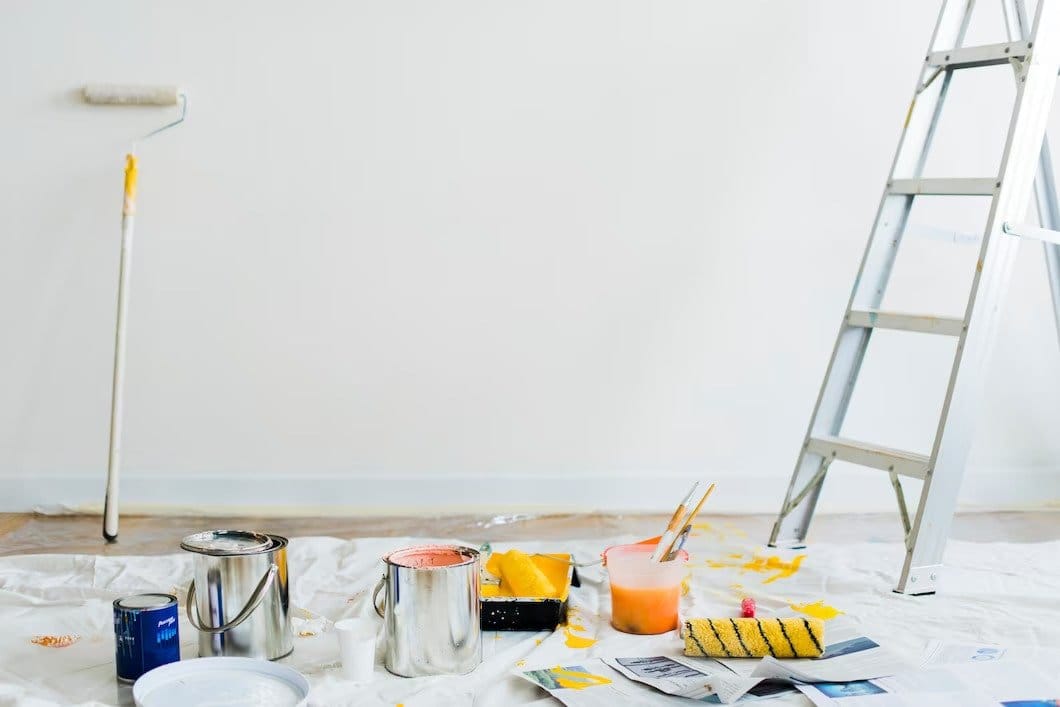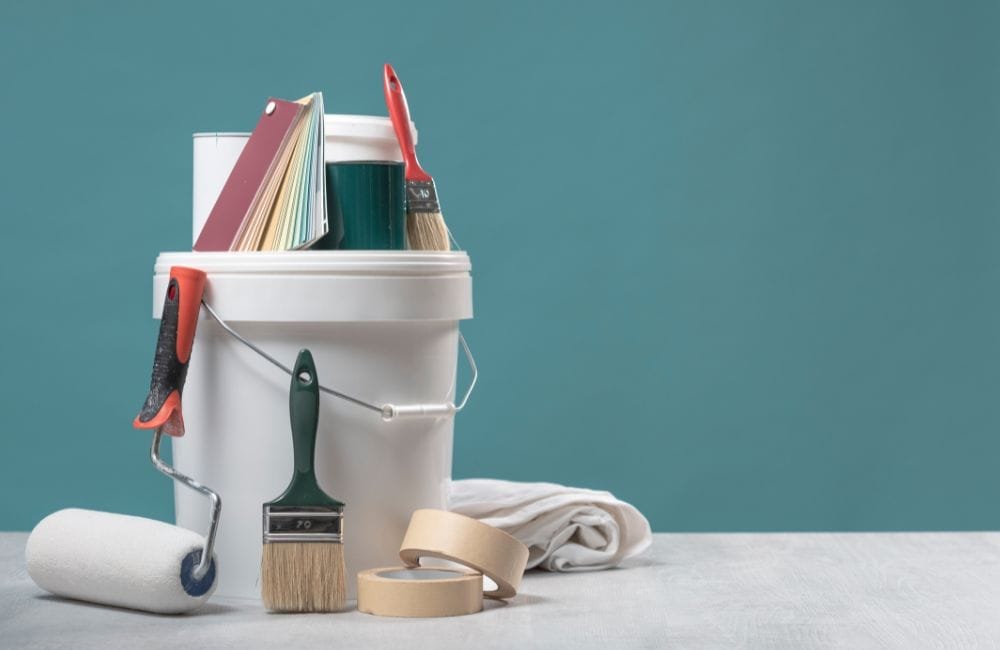
Best Paint for Imperfect Walls: What to Use for Smoother-Looking Drywall
Table of Contents
Key Takeaways
|
Walls are rarely perfect, especially in older homes or spaces that have seen years of wear and tear. Cracks, dents, uneven textures, and other imperfections can make a room look unpolished. Fortunately, the right paint can help minimize these flaws and create a smoother, more refined appearance. Choosing the best paint for imperfect walls involves selecting the right finish, texture, and application techniques to reduce the visibility of blemishes. From paint finishes that hide imperfections to specialized primers that even out surfaces, the right approach can make a significant difference.

Paint Types and Finishes for Imperfect Walls
Walls with imperfections, such as bumps, cracks, or uneven textures, can be challenging to paint. However, selecting the right paint finish can significantly improve the appearance of drywall, helping to conceal flaws and create a more uniform look. Understanding different paint finishes and their benefits is essential when choosing the best paint for imperfect walls.
Matte and Flat Paint
Matte and flat paints are among the best options for walls with noticeable imperfections. These finishes do not reflect light, making flaws like small cracks and dents less visible.
- Low Light Reflection: Matte and flat finishes absorb light rather than bouncing it around, which helps disguise uneven surfaces.
- Smooth, Soft Appearance: These paints create a uniform, velvety look that enhances the overall aesthetic of a room.
- Ideal for Older Walls: They are often considered the best paint for old or damaged walls, as they effectively minimize the visibility of wear and tear.
- Easy Touch-Ups: Unlike glossier finishes, matte and flat paints can be easily touched up without noticeable differences in sheen.
Eggshell and Satin Paint
For those who want a bit more durability while still minimizing imperfections, eggshell and satin finishes provide a balanced option. They offer a slight sheen without making wall flaws stand out.
- Subtle Sheen: Eggshell and satin have a soft glow that reflects light moderately, allowing some depth while still hiding minor wall defects.
- Enhanced Durability: These finishes are more resistant to stains and scuffs than flat paints, making them ideal for high-traffic areas.
- Better for Mildly Textured Walls: They work well for walls with minor bumps and cracks, especially when paired with a high-quality primer.
- More Washable Than Flat Paint: Unlike matte finishes, these paints can be gently wiped clean, making them a good choice for living rooms, hallways, and bedrooms.
Textured Paint
Textured paint is an excellent option for walls with significant surface flaws. Instead of simply hiding imperfections, it adds depth and pattern, making blemishes less noticeable.
- Hides Deep Imperfections: This type of paint for walls with bumps and cracks is specifically designed to cover rough or uneven areas.
- Adds Character: Available in various styles, including sanded and stucco-like finishes, textured paint can enhance a room’s design while concealing flaws.
- Ideal for Older Homes: Works well in spaces where drywall repairs may not create a perfectly smooth surface.
- Low-Sheen for Uneven Surfaces: Most textured paints have a low sheen, which helps minimize the appearance of imperfections
Techniques to Enhance Smoothness
Walls with imperfections, such as bumps, cracks, or uneven surfaces, require careful preparation and application to achieve a smooth, flawless look. Choosing the best paint for imperfect walls is essential, but using the right painting techniques also plays a significant role in minimizing visible flaws.
Primer Use
Applying a high-quality primer is one of the most effective ways to improve the appearance of old or damaged walls before painting. A primer helps smooth out minor surface imperfections and enhances the performance of the topcoat by providing a stable, uniform base.
- Fills Small Imperfections: Primers, especially high-build or self-leveling types, help conceal minor dents, hairline cracks, and uneven textures, making the wall appear smoother once painted.
- Enhances Paint Coverage: Priming the surface helps the paint adhere evenly, preventing patchiness and reducing the number of topcoats required for full coverage.
- Improves Adhesion: A primed surface allows the paint to bond more effectively, preventing issues such as peeling or chipping, which are common on walls with bumps and cracks.
- Prevents Stains from Showing Through: Primers help block stains, discoloration, and previous paint colors from bleeding through for a clean and polished finish.
Multiple Coats
Applying multiple coats of paint is another key technique for improving the appearance of imperfect walls. The additional layers help even out inconsistencies, cover minor surface defects, and create a more polished and uniform finish.
- Builds Up Thickness: Each coat of paint adds another layer, filling in slight depressions, cracks, or uneven textures to create a more consistent surface.
- Reduces Surface Contrast: Applying multiple coats helps blend patched areas and previously painted sections, reducing noticeable differences in texture or color.
- Enhances Durability: A thicker application increases the wall’s resistance to daily wear and tear, making it particularly beneficial for old or damaged walls with weakened surfaces.
- Improves Color Depth and Consistency: Multiple coats enhance the richness of the paint color while preventing streaks or uneven saturation, which is especially important when covering dark or bold previous paint colors.
Painting Tools and Techniques
The choice of painting tools significantly affects the outcome, particularly when working with paint for walls with bumps and cracks. Selecting the right applicator helps minimize streaks, roller marks, and uneven coverage, leading to a smoother and more uniform appearance.
- Roller Application: A high-quality roller with a medium to thick nap (3/8-inch to 3/4-inch) is the best option for covering walls with bumps and cracks. The texture of the roller helps distribute the paint more evenly, filling in minor imperfections while avoiding visible brush strokes.
- Brush Application: Paintbrushes are best used for detailed work, such as cutting in around trim, corners, and edges. However, when used on large wall areas, brushes can leave visible strokes and may not distribute the paint as evenly as a roller.
- Sprayer Option: A paint sprayer provides the smoothest, most seamless finish by eliminating roller texture and brush marks. It is ideal for achieving a professional-quality result, particularly when applying the best paint for imperfect walls over a large area.
- Proper Technique Matters: Using long, even strokes when rolling and maintaining consistent pressure can prevent uneven distribution. Overlapping each pass slightly ensures full coverage while avoiding streaks or missed spots.
Additional Wall Treatments
Walls with visible imperfections require more than just a fresh coat of paint to achieve a smooth, polished look. While choosing the best paint for imperfect walls can help minimize flaws, additional wall treatments can further enhance the surface for a professional finish. Two of the most effective methods include skim coating and decorative alternatives like wallpaper or faux finishes. These solutions can either smooth out the wall completely or creatively mask problem areas.
Skim Coating
Skim coating is a reliable and widely used technique for repairing and smoothing damaged walls before applying paint to walls with bumps and cracks.
- How It Works: Skim coating requires applying a premixed or powdered joint compound in thin layers across the surface. A broad knife or trowel is used to spread the compound smoothly, filling in small holes, cracks, and uneven textures.
- Restores Old or Damaged Walls: This technique is ideal when working with the best paint for old or damaged walls, as it significantly improves the wall’s condition by covering blemishes and creating a uniform base.
- Requires Sanding and Priming: Once the joint compound has fully dried, sanding is necessary to remove any excess texture and ensure a flawless finish. After sanding, applying a primer helps seal the surface, allowing the paint to adhere properly and last longer.
- Enhances Paint Coverage and Durability: Skim-coated walls work particularly well with low-sheen paint for uneven surfaces, as this type of paint further reduces the appearance of minor flaws by diffusing light rather than reflecting it.
Wallpaper and Faux Finishes
For those who want to hide wall imperfections without extensive repairs, wallpaper, and faux finishes provide effective and stylish alternatives. These options can disguise uneven textures while adding decorative interest to a space.
- Textured Wallpaper for Concealment: Thick, embossed, or fabric-backed wallpaper can hide cracks, minor dents, and rough textures. The patterns and raised designs help divert attention from imperfections while adding depth to the walls.
- Faux Painting Techniques for Depth: Painting techniques such as sponging, rag rolling, or color washing create a layered effect that camouflages bumps and surface irregularities. These artistic finishes provide a unique look while preventing imperfections from being too noticeable.
- Plaster and Venetian Finishes for Elegance: Decorative wall finishes, such as Venetian plaster or stucco, create a rich and sophisticated appearance while naturally concealing uneven areas. These methods add texture and dimension, making them an excellent alternative to paint finishes that hide imperfections.
- Long-Lasting and Customizable Solutions: Unlike standard paint, wallpaper, and faux finishes offer long-term solutions with design flexibility. While wallpaper can be changed or removed over time, faux finishes allow for customized patterns that complement the room’s aesthetic.

6 Tips for Choosing Companies to Fix Imperfect Walls
Hiring the right company to repair and refinish imperfect walls is essential for achieving a smooth, polished look. Walls with flaws or uneven surfaces require professional expertise to restore their appearance effectively. Whether the goal is to skim-coat damaged drywall, apply the best paint for imperfect walls, or install decorative finishes, selecting a reliable contractor ensures high-quality results.
Here are key factors to consider when choosing a company to fix imperfect walls.
1. Experience and Specialization Matter
When evaluating companies, it is crucial to consider their experience in handling wall imperfections. Not all painting or drywall contractors specialize in repairing damaged walls, so it is important to choose a team with a proven track record in skim coating, patching, or applying paint for walls with bumps and cracks. A company with years of expertise will have the skills to assess the condition of the walls and recommend the most effective solutions.
2. Reputation and Customer Reviews
A company’s reputation speaks volumes about the quality of its work. Reading customer reviews and testimonials can help gauge the reliability and professionalism of a contractor. Positive feedback often highlights attention to detail, craftsmanship, and adherence to project timelines. It is also beneficial to ask for references and speak directly with past clients to learn about their experiences. Reputable companies that specialize in the best paint for old or damaged walls will have a history of satisfied customers and a strong community presence.
3. Licensing and Insurance
Hiring a licensed and insured contractor is essential for protecting both the homeowner and the workers. A reputable company should have the necessary certifications to perform wall repairs and painting services in compliance with local regulations. Additionally, insurance coverage ensures that any accidental damage or on-site injuries are handled appropriately, preventing unexpected liabilities.
4. Quality of Materials and Techniques
The effectiveness of wall repair and refinishing depends on the contractor’s skills and the materials used. A good company will use high-quality joint compounds, primers, and low-sheen paint for uneven surfaces to achieve a durable and aesthetically pleasing result. Companies that cut costs with subpar materials may deliver temporary fixes that fail over time.
5. Clear Pricing and Written Estimates
Before choosing a painting company, request a detailed written estimate. Transparent pricing helps homeowners understand the costs associated with labor, materials, and additional repairs. A professional contractor should provide a clear breakdown of expenses, ensuring there are no hidden fees or unexpected charges.
6. Warranties and Customer Support
Reliable companies stand by their work and offer warranties for the services provided. A warranty ensures that if any issues arise after the project is completed, the contractor will address them without additional costs. Companies specializing in paint finishes that hide imperfections should guarantee long-lasting results. Additionally, excellent customer support and responsiveness to inquiries indicate a company’s commitment to client satisfaction.
Frequently Asked Questions
Can I use wallpaper instead of paint to hide wall flaws?
Wallpaper can be a great option for covering up wall imperfections. Thicker, textured wallpapers work best because they help disguise uneven surfaces. However, if the wall is severely damaged with deep cracks or peeling paint, the wallpaper may not stick properly. Some people use paintable wallpaper, which adds texture and can be painted over for a custom look. Removing wallpaper later can be difficult, so consider whether you want a long-term or temporary solution. Wallpaper can be a stylish and practical way to improve the look of imperfect walls.
Does white paint make wall imperfections more visible?
Bright white paint can make imperfections stand out more because it reflects a lot of light. If you want a light-colored wall but need to hide flaws, try an off-white, warm beige, or light gray instead. These shades still give a fresh, clean look but are more forgiving of bumps and cracks. Choosing a matte or eggshell finish will also help keep imperfections from being too noticeable.
What is the worst type of paint for hiding wall imperfections?
Glossy or semi-gloss paint is the worst for hiding wall imperfections because it reflects light and makes every bump, crack, or dent stand out. Even satin finishes, which have a slight sheen, can highlight rough textures. While high-shine paints offer durability and easy cleaning, they are unforgiving on uneven walls. For a smooth, uniform look, avoid reflective surfaces and opt for flat or matte finishes, which absorb light and minimize flaws. The wrong finish can make imperfections more noticeable.
Will painting over wallpaper hide wall flaws?
Painting over wallpaper can help disguise wall imperfections, but its effectiveness depends on the wallpaper’s condition. If it’s peeling, bubbling, or textured, flaws may remain visible. A thick primer can help smooth the surface before painting. However, painted wallpaper is harder to remove later, making it a less ideal long-term solution. Removing the wallpaper and properly prepping the wall usually yields better results. While it can be a quick fix, painting over wallpaper isn’t always the best way to hide imperfections
Is there a way to touch up wall imperfections without repainting everything?
You can touch up small wall imperfections without repainting the entire surface. If you have leftover paint, lightly sanding the damaged area and applying a thin coat with a sponge or small roller can help blend the patch. For tiny dents or cracks, using a bit of spackle, sanding it smooth, and dabbing on paint with a brush can work well. If the paint has faded over time, touching up may not blend perfectly, so it’s sometimes better to repaint the whole wall. You can also use a magic eraser or a damp cloth to remove minor scuffs without repainting.

Get Expert Help for Smoother, Flawless Walls in West Hartford, CT!
Struggling with uneven, cracked, or damaged walls? West Hartford House Painting Experts specializes in providing high-quality wall restoration and painting services in West Hartford, CT. Whether your walls need expert patching, skim coating, or the best paint for imperfect walls, our team ensures a smooth, polished finish that enhances your space. Serving homeowners and businesses throughout West Hartford, CT, we use premium materials and professional techniques to hide imperfections and create a flawless look.
Contact West Hartford House Painting Experts today for reliable, expert service in West Hartford, CT, and enjoy walls that look brand new.

